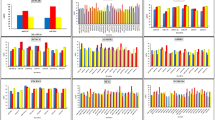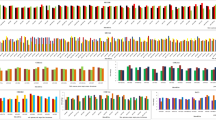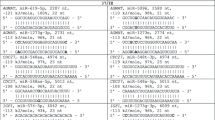Abstract
The microRNAs having a length of ~ 19–22 nucleotides are the small, non-coding RNAs. The evolution of microRNAs in many disorders may hold the key to tackle complex challenges. Oral cancer belongs to the group of head and neck cancer. It occurs in the mouth region that appears as an ulcer. In this study, we collected information on the overexpressed genes of oral cancer. The coding sequences of the genes were derived from NCBI and the entire set of human microRNAs present in miRBASE 21 was retrieved. The human microRNAs that can target the overexpressed genes of oral cancer were determined with the aid of our in-house software. The interaction between microRNAs and the overexpressed genes was evaluated with 7mer-m8 model of microRNA targeting. The genes DKK1 and APLN paired with only one miRNA i.e., miR-447 and miR-6087, respectively. But the genes INHBA and MMP1 were found to be targeted by 2 miRNAs, while the genes FN1, FAP, TGFPI, COL4A1, COL4A2, and LOXL2 were found to be targeted by 16, 5, 9, 18, 29, and 11 miRNAs. Subsequently, several measures such as free energy, translation efficiency, and cosine similarity metric were used to estimate the binding process. It was found that the target region’s stability was higher than the upstream and downstream zones. The overexpressed genes’ GC contents were calculated, revealing that the codons in target miRNA region were overall GC rich as well as GC3 rich. Lastly, gene ontology was performed to better understand each gene’s involvement in biological processes, molecular function, and cellular component. Our study showed the role of microRNAs in gene repression, which could possibly aid in the prognosis and diagnosis of oral cancer.







Similar content being viewed by others
Data availability
The data that support the findings of this study are available in the supplementary material of this article.
Code availability
Not applicable.
References
Lieberman J (2018) Tapping the RNA world for therapeutics. Nat Struct Mol Biol 25(5):357–364
Ling H et al (2015) Junk DNA and the long non-coding RNA twist in cancer genetics. Oncogene 34(39):5003–5011
Nana-Sinkam SP, Croce CM (2011) Non-coding RNAs in cancer initiation and progression and as novel biomarkers. Mol Oncol 5(6):483–491
Ye Y, Shen A, Liu A (2019) Long non-coding RNA H19 and cancer: a competing endogenous RNA. Bull Cancer 106(12):1152–1159
Klec C, Prinz F, Pichler M (2019) Involvement of the long noncoding RNA NEAT1 in carcinogenesis. Mol Oncol 13(1):46–60
Lee RC, Feinbaum RL, Ambros V (1993) The C. elegans heterochronic gene lin-4 encodes small RNAs with antisense complementarity to lin-14. Cell 75(5):843–54
Chen L et al (2019) Trends in the development of miRNA bioinformatics tools. Brief Bioinform 20(5):1836–1852
Vishnoi A, Rani S (2017) MiRNA biogenesis and regulation of diseases: an overview. Methods Mol Biol 1509:1–10
Cai Y et al (2009) A brief review on the mechanisms of miRNA regulation. Genomics Proteomics Bioinform 7(4):147–154
Lin S, Gregory RI (2015) MicroRNA biogenesis pathways in cancer. Nat Rev Cancer 15(6):321–333
Abreu FB, Liu X, Tsongalis GJ (2017) miRNA analysis in pancreatic cancer: the Dartmouth experience. Clin Chem Lab Med 55(5):755–762
Irimie AI et al (2018) Current insights into oral cancer epigenetics. Int J Mol Sci 19(3):670
Sasahira T, Kirita T (2018) Hallmarks of cancer-related newly prognostic factors of oral squamous cell carcinoma. Int J Mol Sci 19(8):2413
Katsanos KH et al (2015) Oral cancer and oral precancerous lesions in inflammatory bowel diseases: a systematic review. J Crohns Colitis 9(11):1043–1052
Jitender S et al (2016) Screening for oral cancer. J Exp Ther Oncol 11(4):303–307
Rivera C (2015) Essentials of oral cancer. Int J Clin Exp Pathol 8(9):11884–11894
Santosh AB, Jones T, Harvey J (2016) A review on oral cancer biomarkers: Understanding the past and learning from the present. J Cancer Res Ther 12(2):486–492
Dumache R (2017) Early diagnosis of oral squamous cell carcinoma by salivary microRNAs. Clin Lab 63(11):1771–1776
Wu Y et al (2017) MiR-375/SLC7A11 axis regulates oral squamous cell carcinoma proliferation and invasion. Cancer Med 6(7):1686–1697
Farooqi AA, Tabassum S, Ahmad A (2017) MicroRNA-34a: a versatile regulator of myriads of targets in different cancers. Int J Mol Sci 18(10)
Shah S et al (2016) miRNA 21: diagnostic prognostic and therapeutic marker for oral cancer. Microrna 5(3):175–179
Zeljic K et al (2018) MicroRNA meta-signature of oral cancer: evidence from a meta-analysis. Ups J Med Sci 123(1):43–49
Bhattacharya A et al (2020) Oncogenes overexpressed in metastatic oral cancers from patients with pain: potential pain mediators released in exosomes. Sci Rep 10(1):1–13
Simkin A et al (2020) Evolutionary dynamics of microRNA target sites across vertebrate evolution. PLoS Genet 16(2):e1008285
Helwak A et al (2013) Mapping the human miRNA interactome by CLASH reveals frequent noncanonical binding. Cell 153(3):654–665
Kertesz M et al (2007) The role of site accessibility in microRNA target recognition. Nat Genet 39(10)1278–1284
Zheng X et al (2020) Prediction of miRNA targets by learning from interaction sequences. PLOS ONE 15(5):e0232578
SantaLucia J (1998) A unified view of polymer, dumbbell, and oligonucleotide DNA nearest-neighbor thermodynamics. Proc Natl Acad Sci 95(4):1460–1465
Riffo-Campos Á, Riquelme I, Brebi-Mieville P (2016) Tools for sequence-based miRNA target prediction: what to choose? Int J Mol Sci 17(12):1987
Ni M et al (2010) Correlation between sequence conservation and structural thermodynamics of microRNA precursors from human, mouse, and chicken genomes. BMC Evol Biol 10(1):329
Zhang B et al (2006) Evidence that miRNAs are different from other RNAs. Cell Mol Life Sci CMLS 63(2):246–254
Dilucca M et al (2015) Codon bias patterns of E. coli’s interacting proteins. PloS One 10(11):e0142127
Freedberg M et al (2020) Identifying site- and stimulation-specific TMS-evoked EEG potentials using a quantitative cosine similarity metric. PLoS One 15(1):e0216185
Conesa A et al (2005) Blast2GO: a universal tool for annotation, visualization and analysis in functional genomics research. Bioinformatics 21(18):3674–3676
Rakhmetullina A et al (2020) In silico prediction of human genes as potential targets for rice miRNAs. Comput Biol Chem 87:107305
Courel M et al (2019) GC content shapes mRNA storage and decay in human cells. Elife. https://doi.org/10.7554/eLife.49708
Uddin A, Paul N, Chakraborty S (2019) The codon usage pattern of genes involved in ovarian cancer. Ann N Y Acad Sci 1:67–78
Cottrell KA, Szczesny P, Djuranovic S (2017) Translation efficiency is a determinant of the magnitude of miRNA-mediated repression. Sci Rep 7(1):14884
Gu W et al (2012) Translation efficiency in upstream region of microRNA targets in Arabidopsis thaliana. Evolut Bioinform 8:EBO.S10362
Correia de Sousa M et al (2019) Deciphering miRNAs’ action through miRNA editing. Int J Mol Sci 20(24):6249
Acunzo M et al (2015) MicroRNA and cancer—a brief overview. Adv Biol Regul 57:1–9
Agarwal V et al (2015) Predicting effective microRNA target sites in mammalian mRNAs. Elife. https://doi.org/10.7554/eLife.05005
McGeary SE et al (2019) The biochemical basis of microRNA targeting efficacy. Science. https://doi.org/10.1126/science.aav1741
Friedman RC et al (2009) Most mammalian mRNAs are conserved targets of microRNAs. Genome Res 19(1):92–105
Peterson SM et al (2014) Common features of microRNA target prediction tools. Front Genet 5:23
Yue D, Liu H, Huang Y (2009) Survey of computational algorithms for microRNA target prediction. Curr Genomics 10(7):478–492
Kakimoto Y et al (2016) MicroRNA stability in FFPE tissue samples: dependence on GC content. PLoS One 11(9):e0163125
Grimson A et al (2007) MicroRNA targeting specificity in mammals: determinants beyond seed pairing. Mol Cell 27(1):91–105
Fabris L et al (2016) The potential of microRNAs as prostate cancer biomarkers. Eur Urol 70(2):312–322
Lee H et al (2016) Biogenesis and regulation of the let-7 miRNAs and their functional implications. Protein Cell 7(2):100–113
Acknowledgements
The authors are grateful to Assam University, Silchar-788011, Assam, India for providing the necessary research facility.
Funding
The work was not funded.
Author information
Authors and Affiliations
Contributions
MM—Conceptualization, Formal analysis, Methodology, and Writing—original draft. DN—Formal analysis, Methodology, and Writing—review & editing. JJG—Review and editing. SC—Conceptualization, Methodology, Validation, Formal data analysis, Investigation, Writing—original draft, Data curation, and Supervision, review & final editing.
Corresponding author
Ethics declarations
Conflict of interest
The authors declare that no competing interest exists in this work.
Ethical statement
Not applicable, the analysis is solely based on nucleic acid sequence data publicly available in databases.
Consent to participate
Not applicable.
Consent for publication
Not applicable.
Additional information
Publisher's Note
Springer Nature remains neutral with regard to jurisdictional claims in published maps and institutional affiliations.
Supplementary Information
Below is the link to the electronic supplementary material.
Rights and permissions
About this article
Cite this article
Moustafa, M.A.A., Nath, D., Georrge, J.J. et al. Binding sites of miRNA on the overexpressed genes of oral cancer using 7mer-seed match. Mol Cell Biochem 477, 1507–1526 (2022). https://doi.org/10.1007/s11010-022-04375-7
Received:
Accepted:
Published:
Issue Date:
DOI: https://doi.org/10.1007/s11010-022-04375-7




